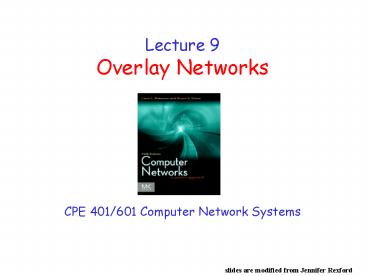Lecture 9 Overlay Networks - PowerPoint PPT Presentation
1 / 24
Title:
Lecture 9 Overlay Networks
Description:
Application-layer multicast is more prevalent Tree of servers delivering the content Collection of end hosts cooperating to delivery video Some multicast within ... – PowerPoint PPT presentation
Number of Views:115
Avg rating:3.0/5.0
Title: Lecture 9 Overlay Networks
1
Lecture 9Overlay Networks
- CPE 401/601 Computer Network Systems
slides are modified from Jennifer Rexford
2
Goals of Todays Lecture
- Motivations for overlay networks
- Incremental deployment of new protocols
- Customized routing and forwarding solutions
- Overlays for partial deployments
- 6Bone, Mbone, security, mobility,
- Resilient Overlay Network (RON)
- Adaptive routing through intermediate node
3
Overlay Networks
4
Overlay Networks
Focus at the application level
5
IP Tunneling to Build Overlay Links
- IP tunnel is a virtual point-to-point link
- Illusion of a direct link between two separated
nodes - Encapsulation of the packet inside an IP datagram
- Node B sends a packet to node E
- containing another packet as the payload
tunnel
Logical view
Physical view
6
Tunnels Between End Hosts
B
Src A Dest B
Src C Dest B
Src A Dest B
A
C
Src A Dest C
Src A Dest B
7
Overlay Networks
- A logical network built on top of a physical
network - Overlay links are tunnels through the underlying
network - Many logical networks may coexist at once
- Over the same underlying network
- And providing its own particular service
- Nodes are often end hosts
- Acting as intermediate nodes that forward traffic
- Providing a service, such as access to files
- Who controls the nodes providing service?
- The party providing the service
- Distributed collection of end users
8
Overlays for Incremental Deployment
9
Using Overlays to Evolve the Internet
- Internet needs to evolve
- IPv6
- Security
- Mobility
- Multicast
- But, global change is hard
- Coordination with many ASes
- Flag day to deploy and enable the technology
- Instead, better to incrementally deploy
- And find ways to bridge deployment gaps
10
6Bone Deploying IPv6 over IP4
tunnel
Logical view
IPv6
IPv6
IPv6
IPv6
Physical view
IPv6
IPv6
IPv6
IPv6
IPv4
IPv4
A-to-B IPv6
E-to-F IPv6
B-to-C IPv6 inside IPv4
B-to-C IPv6 inside IPv4
11
Secure Communication Over Insecure Links
- Encrypt packets at entry and decrypt at exit
- Eavesdropper cannot snoop the data
- or determine the real source and destination
12
Communicating With Mobile Users
- A mobile user changes locations frequently
- So, the IP address of the machine changes often
- The user wants applications to continue running
- So, the change in IP address needs to be hidden
- Solution fixed gateway forwards packets
- Gateway has a fixed IP address
- and keeps track of the mobiles address changes
www.cnn.com
gateway
13
IP Multicast
- Multicast
- Delivering the same data to many receivers
- Avoiding sending the same data many times
- IP multicast
- Special addressing, forwarding, and routing
schemes - Pretty complicated stuff (see Section 4.4)
unicast
multicast
14
MBone Multicast Backbone
- A catch for deploying multicast
- Router vendors wouldnt support IP multicast
- since they werent sure anyone would use it
- And, since it didnt exist, nobody was using it
- Idea software implementing multicast protocols
- And unicast tunnels to traverse non-participants
15
Multicast Today
- Mbone applications starting in early 1990s
- Primarily video conferencing, but no longer
operational - Still many challenges to deploying IP multicast
- Security vulnerabilities, business models,
- Application-layer multicast is more prevalent
- Tree of servers delivering the content
- Collection of end hosts cooperating to delivery
video - Some multicast within individual ASes
- Financial sector stock tickers
- Within campuses or broadband networks TV shows
- Backbone networks IPTV
16
Case Study Resilient Overlay Networks
17
RON Resilient Overlay Networks
- Premise by building application overlay network,
can increase performance and reliability of
routing
Princeton
Yale
application-layer router
Two-hop (application-level) Berkeley-to-Princeton
route
Berkeley
UNR
18
RON Circumvents Policy Restrictions
- IP routing depends on AS routing policies
- But hosts may pick paths that circumvent policies
USLEC
ISP
Patriot
PU
me
My home computer
19
RON Adapts to Network Conditions
B
A
C
- Start experiencing bad performance
- Then, start forwarding through intermediate host
20
RON Customizes to Applications
B
voice
A
bulk transfer
C
- VoIP traffic low-latency path
- Bulk transfer high-bandwidth path
21
How Does RON Work?
- Keeping it small to avoid scaling problems
- A few friends who want better service
- Just for their communication with each other
- E.g., VoIP, gaming, collaborative work, etc.
- Send probes between each pair of hosts
B
A
C
22
How Does RON Work?
- Exchange the results of the probes
- Each host shares results with every other host
- Essentially running a link-state protocol!
- So, every host knows the performance properties
- Forward through intermediate host when needed
B
B
A
C
23
RON Works in Practice
- Faster reaction to failure
- RON reacts in a few seconds
- BGP sometimes takes a few minutes
- Single-hop indirect routing
- No need to go through many intermediate hosts
- One extra hop circumvents the problems
- Better end-to-end paths
- Circumventing routing policy restrictions
- Sometimes the RON paths are actually shorter
24
RON Limited to Small Deployments
- Extra latency through intermediate hops
- Software delays for packet forwarding
- Propagation delay across the access link
- Overhead on the intermediate node
- Imposing CPU and I/O load on the host
- Consuming bandwidth on the access link
- Overhead for probing the virtual links
- Bandwidth consumed by frequent probes
- Trade-off between probe overhead and detection
speed - Possibility of causing instability
- Moving traffic in response to poor performance
- May lead to congestion on the new paths































